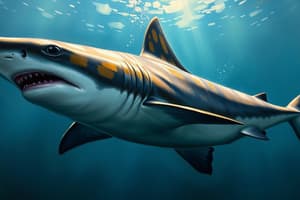Podcast
Questions and Answers
What type of skeleton do cartilaginous fish possess?
What type of skeleton do cartilaginous fish possess?
- Bony skeleton
- Mixed skeleton
- Cartilaginous skeleton (correct)
- Fibrous skeleton
What feature do bony fishes use to help regulate buoyancy?
What feature do bony fishes use to help regulate buoyancy?
- Swim Bladder (correct)
- Operculum
- Fins
- Gill Slits
Which type of scales are found on the skin of bony fishes?
Which type of scales are found on the skin of bony fishes?
- Placoid scales
- Cycloid scales (correct)
- Dermal scales
- Ganoid scales
What anatomical feature does the operculum protect in bony fishes?
What anatomical feature does the operculum protect in bony fishes?
Where is the mouth located in cartilaginous fish?
Where is the mouth located in cartilaginous fish?
What is the function of dorsal fins in cartilaginous fishes?
What is the function of dorsal fins in cartilaginous fishes?
Which strategy do cartilaginous fishes use to maintain buoyancy?
Which strategy do cartilaginous fishes use to maintain buoyancy?
What is the primary purpose of the internal line system in cartilaginous fishes?
What is the primary purpose of the internal line system in cartilaginous fishes?
What type of fins are located on the sides of cartilaginous fishes and are used for steering?
What type of fins are located on the sides of cartilaginous fishes and are used for steering?
What characteristic distinguishes bony fishes from cartilaginous fishes regarding buoyancy?
What characteristic distinguishes bony fishes from cartilaginous fishes regarding buoyancy?
Flashcards
Internal Line System
Internal Line System
A system of sensory receptors running along the sides of cartilaginous fishes, detecting changes in water pressure, movement, and vibrations, aiding in navigation, hunting, and predator avoidance.
Swim Bladder
Swim Bladder
A gas-filled organ found in bony fishes, helping them maintain buoyancy in water, but absent in cartilaginous fishes.
Buoyancy in Cartilaginous Fishes
Buoyancy in Cartilaginous Fishes
Cartilaginous fishes lack a swim bladder and use a large, oily liver and active swimming to maintain neutral buoyancy.
Cloaca
Cloaca
Signup and view all the flashcards
Fins in Cartilaginous Fishes
Fins in Cartilaginous Fishes
Signup and view all the flashcards
Cartilaginous Fish Skeleton
Cartilaginous Fish Skeleton
Signup and view all the flashcards
Bony Fish Skeleton
Bony Fish Skeleton
Signup and view all the flashcards
Operculum
Operculum
Signup and view all the flashcards
Placoid Scales
Placoid Scales
Signup and view all the flashcards
Study Notes
Chondrichthyes (Cartilaginous Fishes)
- Internal Line System: A series of sensory receptors along the sides of the body detect water pressure, movement, and vibrations; aiding navigation, hunting, and predator avoidance.
- Buoyancy: Lack a swim bladder; rely on a large, oily liver for neutral buoyancy and active swimming to maintain position.
- External Anatomy: Cartilaginous skeleton, placoid scales (tiny, tooth-like scales), multiple gill slits, mouth on underside with teeth, nostrils, and well-developed eyes.
Osteichthyes (Bony Fishes)
- External Anatomy: Bony skeleton, operculum (bony flap covering gills), swim bladder (gas-filled sac for buoyancy control), scales, various fins for swimming, steering, and balance (dorsal, caudal, pectoral, pelvic).
- Swim Bladder: A gas-filled sac allowing bony fishes to regulate buoyancy.
Reptiles
- Oviparity (Egg-Laying): Female reptiles lay fertilized eggs, often in nests or buried in soil.
- Viviparity (Live Birth): Female reptiles give birth to live young, with nourishment provided through a placental-like structure or yolk sac.
- Ovoviviparity (Egg-hatching Inside the Mother): Female reptiles retain fertilized eggs inside their bodies until hatching.
- Orders of Reptiles: Testudines (turtles and tortoises), Squamata (lizards and snakes), Crocodilia (crocodiles, alligators), Sphenodontia (Tuataras).
- Internal Anatomy: Digestive system (mouth, esophagus, stomach, intestines, cloaca), respiratory system (lungs), circulatory system, excretory system, nervous system, reproductive system.
- Parthenogenesis in Reptiles: A rare form of asexual reproduction, observed in some lizards and snakes. Unfertilized egg develops into an offspring.
Amphibians
- Three Main Orders: Anura (frogs and toads), Caudata (salamanders and newts), Gymnophiona (caecilians).
Birds (Class Aves)
- Respiratory System: Lungs and air sacs; unidirectional airflow for efficient oxygen intake.
- Circulatory System: Four-chambered heart, maximizing oxygen delivery.
- Digestive System: Beak, crop, gizzard, and intestines.
- Nervous System: Relatively large brain, well-developed senses.
Mammals
- General Characteristics: Hair or fur, mammary glands, endothermy, four-chambered heart.
- Ways of Giving Birth: Placental mammals, marsupials, monotremes.
- Groups: Rodentia (rats, mice, squirrels), Chiroptera (bats), Carnivora (dogs, cats, bears), Primates (humans, monkeys), Artiodactyla (cows, deer), Perissodactyla (horses, zebras), Cetacea (whales, dolphins), Sirenia (manatees).
Aquatic and Marine Mammals
- Respiratory System: Adaptations to breathe air in water (e.g., complex social structures; echolocation). Examples include whales, dolphins, porpoises, seals, sea lions, walruses.
Studying That Suits You
Use AI to generate personalized quizzes and flashcards to suit your learning preferences.



